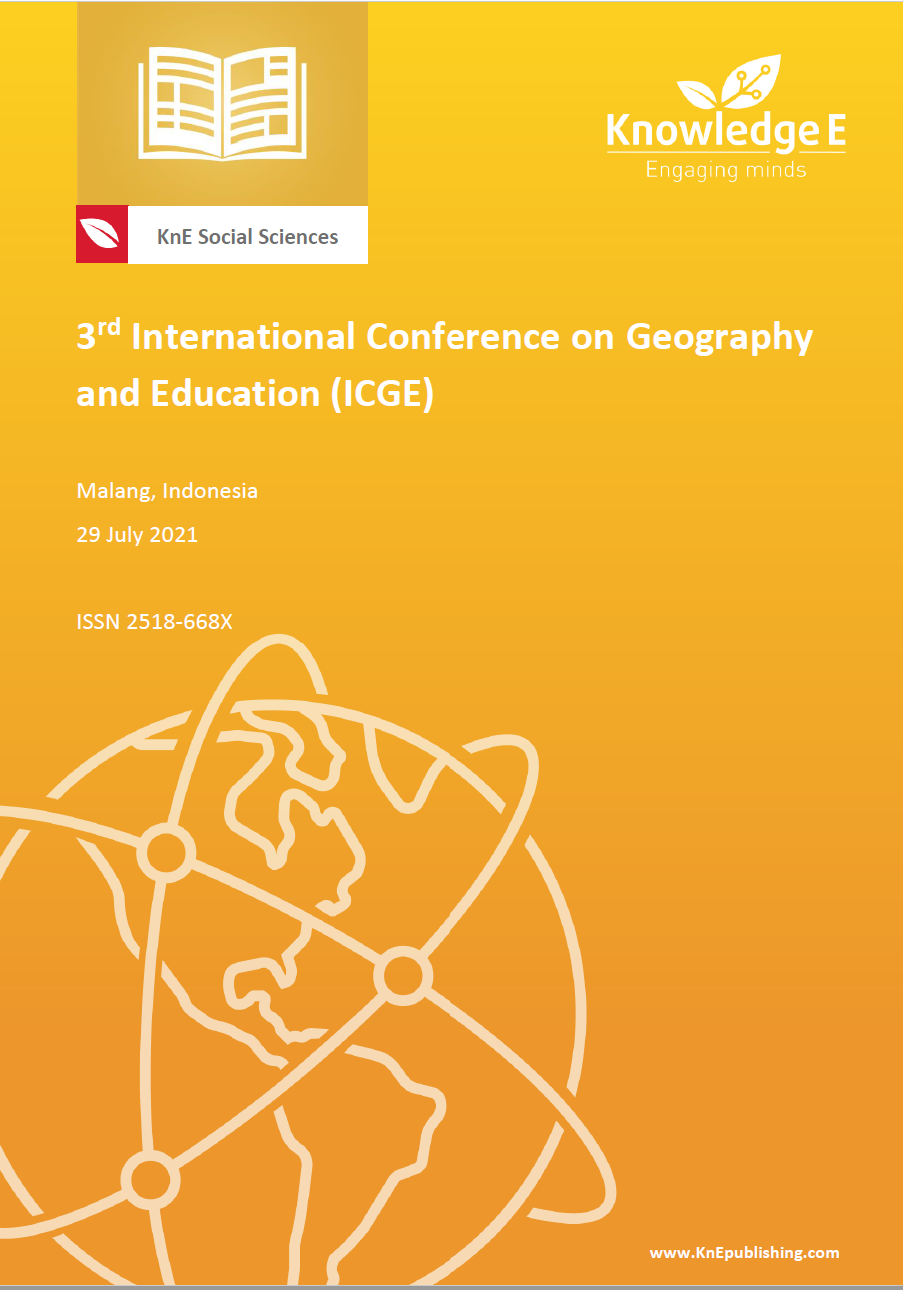Rajeboning Infographic Project Based Outdoor Learning: Efforts to Use the Liang Ulin 2 Site as a History Learning Source
DOI:
https://doi.org/10.18502/kss.v7i16.12179Abstract
Interaction with many learning resources and motivated students are some of the indicators of ideal historical learning. The concept of Rajeboning (infographic project based outdoor learning) can be used to support historical learning. Furthermore, examining Liang Ulin 2 (which is still unexplored) and its artifacts can help to spur historical learning. This research involved the five steps of historical research (topic selection, heuristics, criticism, interpretation and historiography), as well as a qualitative research-based literature study. The archaeological and historical potential of Liang Ulin 2 can be reviewed from the findings of artifacts which include: stone artifacts (lithic), earthenware shards, jewelry, shells, bones, teeth, and ochre. The utilization of the Liang Ulin 2 Site as a historical source using the concept of Rajeboning consists of three stages: session 1 (orientation); session 2 (execution); and session 3 (appreciation). The three sessions are expected to motivate students and thus realize the real purpose of historical learning.
Keywords: Liang Ulin 2, learning resource, Rajeboning, outdoor learning, projectbased learning
References
[2] Sugiyanto B. Potensi arkeologi prasejarah kabupaten tanah bambu dan ancaman yang dihadapinya. Naditira Widya - Balai Arkeologi Banjarmasin. 2015;9(1):1–14. https://doi.org/10.24832/nw.v9i1.117
[3] Fajari NME, Oktrivia U. Liang ulin 2 informasi baru prasejarah Kalimantan selatan. Naditira Widya - Balai Arkeologi Kalimantan Selatan. 2015;9(2):93–106.
[4] Kuntowijoyo PD. Pengantar ilmu sejarah. Bentang Budaya; 2005.
[5] Universitas Pendidikan Ganesha Indonesia, Widja IG. Pembelajaran sejarah yang mencerdaskan suatu alternatif menghadapi tantangan dan tuntutan jaman yang berubah. Jurnal Pendidikan Sejarah Indonesia. 2018;1(2):117–134. https://doi.org/10.17977/um033v1i22018p117
[6] Bradley R. The past in prehistoric societies. 1st ed. United Kingdom: Routledge; 2002.
[7] Soedjatmoko. 1976. “Kesadaran Sejarah dan Pembangunan”. Prisma. Vol. V. No. 7.
[8] Kochhar SK. Teaching of history. Grasindo Jakarta; 2008.
[9] Subakti YR. Paradigma pembelajaran sejarah. 2021 Jun 20 Studylibid. Available from: https://studylibid.com/doc/116785/paradigma-pembelajaran-sejarah-yr-subakti
[10] Hartata R. Meningkatkan motivasi dan prestasi belajar sejarah dengan problembased learning (PBL). Penerbit Lakeisha, Jawa Tengah; 2020.
[11] Ramos PH, De La Paz S. Learning history in middle school by designing multimedia in a project-based learning experience. Journal of Research on Technology in Education. 2009;42(2):151–173.
[12] Hosnan M. Pendekatan saintifik dan kontekstual dalam pembelajaran abad 21: Kunci sukses implementasi kurikulum 2013. Ghalia Indonesia, Sidoarjo; 2014. Available from: http://repo.unikadelasalle.ac.id/index.php?p=show_detail&id=11129&keywords=
[13] Sulistyo WD, Khakim MNL, Kurniawan B. Learning experience from learning sources: Exploiting geographic and historical potential of guerrilla sites in Wonokarto Pacitan as a source of historical learning. IOP Conference Series: Earth and Environmental Science. 2020;485(1): 012109.
[14] Smiciklas M. The power of infographics: Using pictures to communicate and connect with your audiences. 1st ed. Que Publishing, River Street, Hoboken; 2012.
[15] Miftah MN, Rizal E, Anwar RK. Pola literasi visual infografis dalam pembuatan informasi grafis (infografis). Jurnal Kajian Informasi & Perpustakaan. 2016;4(1):87–94.
[16] Senjaya WF, Karnalim O, Handoyo ED et al. Peran infografis sebagai penunjang dalam proses pembelajaran siswa. Abdimas Altruis: Jurnal Pengabdian Kepada Masyarakat. 2019;2(1):55–62.
[17] Gainau MB. Pengantar metode penelitian. PT Kanisius,Kota Surabaya; 2016.
[18] Zed M. Metode penelitian kepustakaan. Yayasan Pustaka Obor Indonesia, Daerah Istimewa Yogyakarta; 2004.
[19] Sugiyanto B. Kubur dan manusia prasejarah di pegunungan meratus, provinsi Kalimantan Selatan. Jurnal Kebudayaan. 2017;12(2):135–144. https://doi.org/10.24832/jk.v12i2.249
[20] Ullman M, Hovers E, Goren-Inbar N, Frumkin A. Levantine cave dwellers: Geographic and environmental aspects of early humans use of caves, case study from Wadi Amud, northern Israel. Paper presented at: 16th International Congress of Speleology; July, 2013 Wadi Amud, northern Israel.
[21] Fajari NME. Tipologi artefak batu liang ulin 2: Analisis fungsional berdasarkan morfologi. Naditira Widya - Balai Arkeologi Kalimantan Selatan. 2016;10(2):81–96.
[22] Simanjutak T, Yuniawati DY, Harkantiningsih N, Hardiati ES, Sonny W, Aziz FA. Metode penelitian arkeologi. Pusat Penelitian dan Pengembangan Arkeologi Nasional, Badan Pengembangan Sumberdaya Kebudayaan dan Pariwisata, Departemen Kebudayaan dan Pariwisata; 2008.
[23] Smeysters C, Rollit M. Glossary of lithic terms. Simon Fraser University, Kanada; 2017. Available from: https://www.sfu.ca/archaeology/museum/tse-k-wa/tse-k-wadigital- lithics-exhibit/glossary-of-terms.html
[24] Oktrivia U, Hindarto I, Herwanto E. Potensi arkeologi di sekitar bukit ulin, kecamatan mantewe, kabupaten tanah bumbu. Berita Penelitian Arkeologi - Balai Arkeologi Kalimantan Selatan. 2016;10:1–37.
[25] Fajar NME, Wibisono MW. Batu cave: Prehistoric occupation of Meratus mountains, South Kalimantan. Berkala Arkeologi. 2020;40(2):179–194. https://doi.org/10.30883/jba.v40i2.518
[26] Samsinar S. Urgensi learning resources (sumber belajar) dalam meningkatkan kualitas pembelajaran. Didaktika: Jurnal Kependidikan. 2019;13(12):194–205.
[27] Karppinen SJA. Outdoor adventure education in a formal education curriculum in Finland: Action research application. Journal of Adventure Education & Outdoor Learning. 2012;12:41–62.
[28] Sandrayati E. View of upaya meningkatkan kemampuan kerja sama peserta didik melalui model project-based learning di mi no 29/e.3 hiang tinggi. Jurnal Edu Research: Indonesian Institute for Corporate Learning and Studies (IICLS). 2021;2(2):23–29.
[29] Warsono W Kemampuan berapresiasi siswa melalui kegiatan pameran sekolah di sma negeri 3 slawi. Universitas Negeri Semarang, Semarang Indonesia; 2013.
[30] Ismaun I. Pengantar belajar sejarah sebagai ilmu dan wahana pendidikan. Bandung: Historia Utama Press; 2005. Available from: opacperpustakaan. ummi.ac.id/index.php?p=show_detail&id=11513

